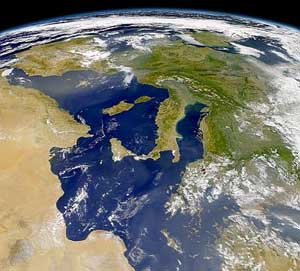Geography of Italy




Italy is located in southern Europe and comprises the short, sandal-shaped Italian Peninsula, the land between the peninsula and the Alps, and a number of islands including Sicily and Sardinia. Corsica is often mistaken to be an Italian island but in fact has been a part of France since 1769. Its total area is 301,230 square kilometres (116,310 sq mi), of which 294,020 km2 (113,520 sq mi) is land and 7,210 km2 is water (2,784 sq mi).
Italy borders with Switzerland (740 km (460 mi)*), France (488 km (303 mi)*), Austria (430 km (270 mi)*) and Slovenia (232 km (144 mi)*). San Marino (39 km (24 mi)*) and Vatican city (0.44 km (0.27 mi)*) are both entirely surrounded by Italy.
Including islands, Italy has a coastline of 7,600 kilometres (4,700 mi) on the Adriatic, Ionian, Tyrrhenian and Ligurian Sea.
Highest peak in Italy is Mont Blanc, at 4,810 metres (15,780 ft) above sea level.
Italy is a mountainous country, with the Alps as the northern boundary and the Apennine Mountains forming the backbone of the peninsula, but in between the two lies a large plain in the valley of the Po, the largest river in Italy, which flows 652 km (405 mi) eastward from the Cottian Alps to the Adriatic. Worldwide-known mountains in Italy are Matterhorn (Cervino), Monte Rosa, Gran Paradiso in the West Alps, and Bernina, Stelvio and Dolomites along the eastern side of the Alps.
Most of Italy's rivers drain either into the Adriatic Sea (like Po, Piave, Adige, Reno) or into the Thyrrenian (like Arno, Tiber and Volturno), though the waters from some border municipalities (Livigno in Lombardy, Innichen and Sexten in Trentino-Alto Adige/Südtirol) drain into the Black Sea through the basin of the Drava, a tributary of the Danube, and the waters from the Lago di Lei in Lombardy drain into the North Sea through the basin of the Rhine.
In the north of the country are a number of subalpine lakes, the largest of which is Garda (370 km2 (143 sq mi)*). Other well known of these subalpine lakes are Lake Maggiore (212.5 km2 (82 sq mi)*), whose most northerly section is part of Switzerland, and Lake Como (146 km2 (56 sq mi)*).
Several islands form part of Italy. The largest are Sicily 25,708 km2 (9,926 sq mi) and Sardinia 24,090 km2 (9,301 sq mi). The third island is Elba, the largest island of the Tuscan Archipelago (224 km2 (86 sq mi)*).
There are also a few active volcanoes in Italy: Etna, the largest active volcano in Europe; Vulcano; Stromboli; and Vesuvius, the only active volcano on the mainland of Europe.
Statistics
- Natural resources
- Mercury, potash, marble, sulfur, dwindling natural gas and crude oil reserves, fish, coal, arable land
- Land use
-
- Arable land: 31%
- Permanent crops: 8%
- Permanent pastures: 25%
- Forests and woodland: 15%
- Other: 21% (1993 est.)
- Irrigated land
- 27,100 square kilometres (10,500 sq mi) (1993 est.)
- Natural hazards
- Regional risks include landslides, mudflows, avalanches, earthquakes, volcanic eruptions, flooding; land subsidence in Venice
- Maritime claims
-
- Contiguous zone: 24 nmi (44.4 km; 27.6 mi)
- Continental shelf: 200-metre depth (660 ft) or to the depth of exploitation
- Territorial sea: 12 nmi (22.2 km; 13.8 mi)
- Environment—current issues
- Air pollution from industrial emissions such as sulphur dioxide; coastal and inland rivers polluted from industrial and agricultural effluents; acid rain damaging lakes; inadequate industrial waste treatment and disposal facilities
- Environment—international agreements
-
- Party to: Air Pollution, Air Pollution-Nitrogen Oxides, Air Pollution-Organic Compounds, Antarctic-Environmental Protocol, Antarctic Treaty, Biodiversity, Climate Change, Desertification, Endangered Species, Environmental Modification, Hazardous Wastes, Law of the Sea, Marine Dumping, Nuclear Test Ban, Ozone Layer Protection, Ship Pollution, Tropical Timber 83, Tropical Timber 94, Wetlands, Whaling, Air Pollution-Persistent Organic Pollutants, Climate Change-Kyoto Protocol
- Geography—note
- Strategic location dominating central Mediterranean as well as southern sea and air approaches to Western Europe.
